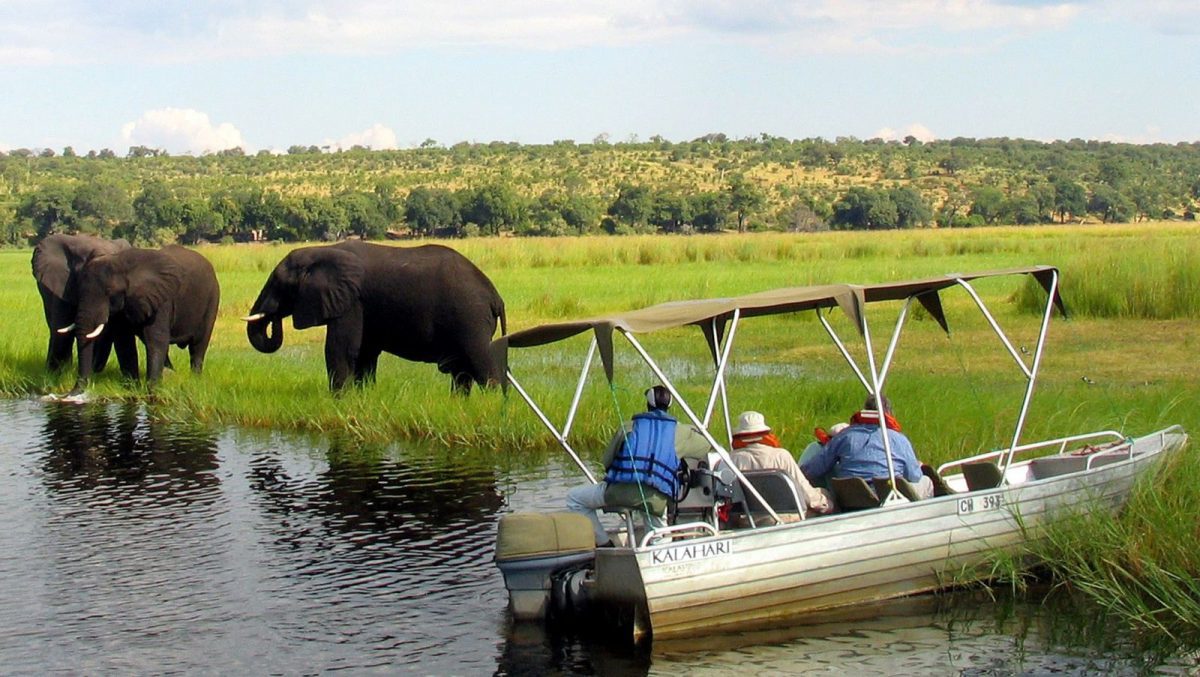The Chobe National Park in northern Botswana is a 11,700 sq km (4,517 sq mile) sanctuary for animals. Families of endangered African elephants wander freely through the park, which is bordered by Namibia in the north and Zimbabwe in the east. The animals visit watering holes, feed on the lush vegetation, and play with the youngest of their groups.
African elephants in nearby countries such as Zimbabwe, Zambia, and Namibia are migrating to parks like Chobe, where strict anti-poaching policies allow them to thrive. Botswana is now home to roughly 130,000 elephants—a third of Africa’s entire elephant population. This is an increase of over 30,000 elephants in Botswana since 1995 against a backdrop of declining numbers across the continent.
In 2016 the Great Elephant Census published the first-ever continent-wide, standardized survey of African savannah elephants. The census found that savannah elephant populations in Africa fell by an estimated 30%—or 144,000 animals in total—between 2007 and 2014. Today there are only around 350,000 left on the entire continent. The survey authors blamed poaching as the primary reason for the decline.
The 2016 survey did not include forest elephants, whose populations are difficult to discern because they live in dense, forested areas and would require labor-intensive ground counts to survey. Estimates suggest there are only 100,000 left today. In total, it’s believed that there were over 1 million elephants in Africa in the 1970s, and possibly more than 2 million at the beginning of the 20th century.
Botswana, however, has become a safe haven for the world’s largest land mammals. “Elephants are using well-known migratory routes into Botswana to flee threats from neighboring countries,” says Mark Hiley, cofounder of the UK-based nonprofit National Park Rescue. “The systematic movement of elephants into Botswana is linked to their survival.”
Elephants like these in the Chobe National Park are developing survival mechanisms in response threats.
Elephants like these in the Chobe National Park are developing survival mechanisms in response threats. (Kanika Saigal)
Communicating for survival
Researchers believe this migration is just one survival mechanism elephants have developed in response to poaching, conflict, urbanization, agriculture, and other pressures in Africa.
In 2016, one elephant made a treacherous 209 km (130 mile) journey over three weeks from the relative safety of Kenya to conflict-ridden Somalia, all under the cloak of darkness. Morgan, as the researchers called him, remained in Somalia for just a day and a half before turning back.
“We don’t know the precise reason for his migration into Somalia,” says Iain Douglas-Hamilton, founder of Save the Elephants, a UK charity headquartered in Nairobi that conducts research on elephant behavior and ecology, “but we suspect it was to mate.”
“Moving by night was an extreme form of survival in a region where elephants are under threat from poaching,” adds Douglas-Hamilton. “He was the first elephant on record to visit in Somalia in 20 years.”
Inspired by the elephant’s journey, researchers at the University of Twente in the Netherlands worked with Save the Elephants to conduct a study last September on African elephant migratory patterns. They found that some elephants in sub-Saharan Africa have started uncharacteristically travelling at night to avoid the threat of poaching that usually occurs during the day.
Elephants also have developed sophisticated gestures, sounds, infrasound, and even chemical secretions to relay messages to one another for survival purposes. “Through various means, elephants can suggest that the group moves on, that they sense danger, or that they are in distress,” says Douglas-Hamilton.
Indeed, it’s not just where elephants are going that’s of interest to researchers, but when, and how they’re communicating about it within groups, between herds, and across generations. In 1977, Mozambique gained independence from Portuguese colonial rule; two years later the country collapsed into civil war. By the time the war ended in 1992, over a million people had been killed and 5 million others had been displaced. During the conflict, soldiers ate elephant meat and traded the animals’ ivory for weapons and ammunition, says Joyce Poole, cofounder and scientific director of ElephantVoices, an organization that studies the social behavior and communication of African elephants. Mozambique’s elephant population was completely decimated: 90% of the 4,000 elephants that lived in the greater Gorongosa area in central Mozambique, where much of Poole’s research has focused, had been killed.











